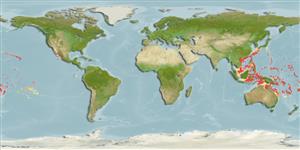>
Acropomatiformes (Oceanic basses) >
Symphysanodontidae (Slopefishes)
Etymology: Symphysanodon: Greek, syn, symphysis = grown together + Greek, physis = growth body form + Greek, odous = teeth; related to few teeth which are located over the area where the two jaws meet (Ref. 45335).
More on author: Bleeker.
Environment: milieu / climate zone / depth range / distribution range
पारिस्थितिकी
समुद्री बेनथोपिलाजिक; गहराई सीमा 50 - 400 m (Ref. 54833). Deep-water
Pacific Ocean: Indonesia (off Lombok and the Kai Islands) and the Philippines (off Luzon) to the Hawaiian Islands.
आकार / वज़न / Age
Maturity: Lm ? range ? - ? cm
Max length : 17.0 cm SL पुल्लिंग / अलिंग; (Ref. 9831)
Inhabits deep offshore trawling grounds (Ref. 54833). Probably feeds on zooplankton. Reported to be frequently consumed by the lutjanid Pristipomoides at Pathfinder Reef, Mariana Archipelago (Ref. 54833).
Life cycle and mating behavior
Maturities | पुनरुत्पत्ति | Spawnings | Egg(s) | Fecundities | लार्वा
Anderson, W.D. Jr., 1999. Symphysanodontidae. Bunquelovelies (also wampeejawed fishes, slopefishes, and shelf beauties). p. 2438-2441. In K.E. Carpenter and V.H. Niem (eds.) FAO species identification guide for fishery purposes. The living marine resources of the Western Central Pacific. Volume 4. Bony fishes part 2 (Mugilidae to Carangidae). FAO, Rome. (Ref. 9831)
IUCN Red List Status (Ref. 130435)
Threat to humans
Harmless
Human uses
मात्स्यिकी: लघु वाणिज्य
साधन
Special reports
Download XML
इंटरनेट स्रोत
Estimates based on models
Preferred temperature (Ref.
123201): 14.8 - 26.4, mean 20.7 °C (based on 157 cells).
Phylogenetic diversity index (Ref.
82804): PD
50 = 0.5004 [Uniqueness, from 0.5 = low to 2.0 = high].
Bayesian length-weight: a=0.01122 (0.00514 - 0.02450), b=3.04 (2.87 - 3.21), in cm total length, based on all LWR estimates for this body shape (Ref.
93245).
Trophic level (Ref.
69278): 3.5 ±0.5 se; based on size and trophs of closest relatives
Fishing Vulnerability (Ref.
59153): Low vulnerability (11 of 100).
